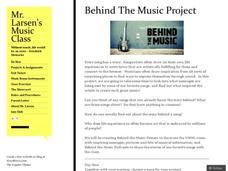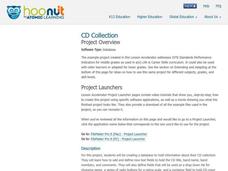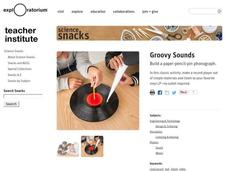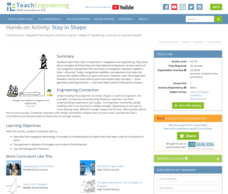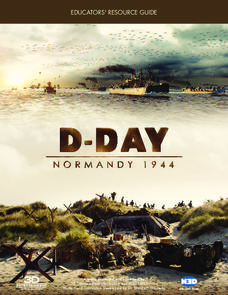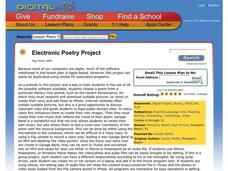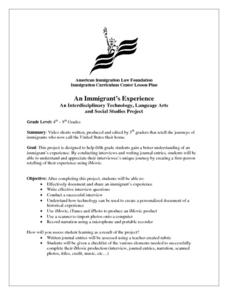Computer Science Unplugged
Beat the Clock—Sorting Networks
Can multiple computers sort a list faster than one? Using a network drawn with chalk outside, groups move through the decision network to sort numbers. A series of extension questions come with the lesson and can be used in the same...
Pittsburgh Ballet Theatre
West Side Story Suite and In The Night Fancy Free
West Side Story and Romeo & Juliet—two classics in their own rights that help young literature lovers better analyze different works. Learners research and compare the characters and story elements of West Side Story and Romeo...
Wordpress
Behind the Music Project
Authors write about what they know, and that does not exclude songwriters. Invite partners to explore the story behind a song. They analyze and discuss the lyrics, conduct research online, create a poster, and put together a two-minute...
IOP Institute of Physics
Physics in Concert
What do physicists and musicians have in common? A lot more than you might think. After first viewing a slide show presentation and completing a series of skills practice worksheets on the physics of light, sound, and...
Teach Engineering
Edible Rovers (High School)
Design and build a rover ... then eat it? This activity has groups of two design and build Mars rovers. The teams determine what instruments they want to include with their rover and plan a budget. They calculate the cost of the body of...
Curated OER
Tech Integration Project Lesson Accelerator: Project Overview
Prepare middle schoolers for life in the tech world with a lesson on entering, storing, sorting, and creating database collections. They use a database tool, such as excel, to record the contents of their CD collections. They then...
PBS
Heart to Heart
Study heart health and math in one activity. After measuring their resting heart rates by finding the pulse in their wrists, learners build a stethoscope to listen to their heart rate, and note the differences between the two methods.
DiscoverE
Laser Challenge
Help your class become laser focused on the connection between sound and light. Scholars set up mirrors to bend and direct lasers that are connected to a music source. Music should start playing when the laser hits the photoresistor.
Beauty and Joy of Computing
Building Your Own Blocks
Isn't building with blocks an activity for toddlers? The third lab of a five-part unit teaches young computer scientists how to create their own block instructions for programming. They use these blocks to create geometric figures, spell...
Teach Engineering
Edible Rovers
The good thing about building this rover is you get to eat it afterwards. Pairs determine rover parts they want to include in their design based upon their cost and usefulness. The teams design their rovers, build them from edible...
Exploratorium
Groovy Sounds
Make music. Class members construct a simple record player using a paper cone and a pin. The resource provides a description of what is happening and why listeners can hear the sounds through the cone.
Teach Engineering
Stay in Shape
Using their knowledge of right triangles, pupils find out how far a ship is from a light house. Class members determine how far around the world a ship would be sailing at a constant speed.
D-Day Normandy 1944
D-Day Normandy 1944
No study of World War II would be complete without an in-depth examination of the events of June 6, 1944. Pascal Vuong's D-Day Normandy:1944, is the perfect vehicle to convey the sheer magnitude of the events that have been called...
Curated OER
The Physics of Sports: An 8th Grade Physical Science Project
Explore the relationship between sports and physics in a cross-curricular lesson. Middle and high schoolers prepare a multimedia presentation based on a chosen sport. They answer five physics vocabulary questions about how the laws of...
Computer Science Unplugged
The Intelligent Piece of Paper
How smart is that piece of paper? The activity introduces the idea of computer programming as a list of instructions written by computer programmers. Two individuals play a game of Tic-Tac-Toe in which one follows the commands...
Exploratorium
Sound Bite
Learners use their teeth for more than just eating. The activity shows class members how to send sound through their teeth by using an electric motor connected to a radio to generate vibrations. Biting on the motor...
Curated OER
Movie Making
Students use a program titled Movie Maker to create movies on the computer. In this movies lesson plan, students create scenes, add background music, and more.
Curated OER
Historical Interview Project
Students interview a subject about important historical events in his or her lifetime and create an iMovie of the experience. Era-related data is imported into the project from a variety of sources and presented to the rest of the class.
Curated OER
Periodic Table of Fun
Are you looking to put the fun back in the fundamentals of chemistry? Why not have groups create their own periodic tables of something (animals, food, music groups, etc.) practicing the organizational strategies used in the periodic...
Hackers Lesson Plan Template
Describe the threat of viruses to computer/ network.
Illustrate the methods for avoiding attacks.
Explain the consequences of social, illegal, and unethical uses of technology (e.g., piracy; illegal downloading; licensing...
Shmoop
ELA.CCSS.ELA-Literacy.SL.11-12.5
If you allow the space for your class members to be creative with technology as they make a presentation, they will make you proud with their inventiveness. The resource suggests an open research project for which pupils look up...
Curated OER
Electronic Poetry Project
Learners create a digital project to go with a poem. In this technology instructional activity, students pick a poem and create images to go with it. They make background music for the narration of their poem and attach it to a...
American Immigration Law Foundation
An Immigrant’s Experience
After interviewing an immigrant about their voyage to the United States and first impressions of the country, young learners create a fictional series of journal entries and design an iMovie depicting their interviewee's story.
Curated OER
Nervous System
Get to know the body's central nervous system through an engaging game of nervous system telephone. But this isn't your average game of telephone. Here, pupils must find a way to communicate a message to the brain without speaking....


